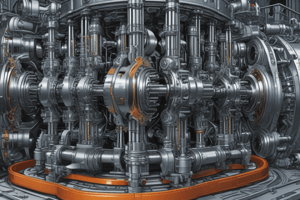Podcast
Questions and Answers
What is the primary purpose of lubrication in machines?
What is the primary purpose of lubrication in machines?
- To enhance the appearance of machine parts
- To minimize energy loss due to friction (correct)
- To increase operational speed
- To reduce the impact of vibrations
Which characteristic of a lubricant is essential for preventing metal contact and scoring between gear teeth?
Which characteristic of a lubricant is essential for preventing metal contact and scoring between gear teeth?
- Adhesion
- Cooling capacity
- Chemical stability
- Film strength (correct)
In which type of lubrication is a thick film of lubricant formed to prevent direct contact between surfaces?
In which type of lubrication is a thick film of lubricant formed to prevent direct contact between surfaces?
- Solid lubrication
- Hydrodynamic lubrication (correct)
- Extreme pressure lubrication
- Boundary lubrication
What is one of the key functions of a lubricant regarding heat?
What is one of the key functions of a lubricant regarding heat?
Which property of lubricants aids in preventing the loss of lubrication due to centrifugal forces?
Which property of lubricants aids in preventing the loss of lubrication due to centrifugal forces?
What type of lubrication occurs when lubrication film thickness fails, but extreme pressure protection is provided?
What type of lubrication occurs when lubrication film thickness fails, but extreme pressure protection is provided?
Why is viscosity an important characteristic of lubricants?
Why is viscosity an important characteristic of lubricants?
What is one result of lubrication in terms of machine lifespan?
What is one result of lubrication in terms of machine lifespan?
What is the primary feature of structural lubricants that makes them effective?
What is the primary feature of structural lubricants that makes them effective?
Which type of lubricant is specifically designed for extreme conditions like those in aircraft engines?
Which type of lubricant is specifically designed for extreme conditions like those in aircraft engines?
Which of the following lubricants is commonly used in rocketry and defense programs due to its high-temperature stability?
Which of the following lubricants is commonly used in rocketry and defense programs due to its high-temperature stability?
What is a disadvantage of gas lubrication compared to liquid or solid lubricants?
What is a disadvantage of gas lubrication compared to liquid or solid lubricants?
Which material is known for being thermally stable and anti-corrosive, and is used in aircraft turbines?
Which material is known for being thermally stable and anti-corrosive, and is used in aircraft turbines?
What is a common property of chemically active lubricants?
What is a common property of chemically active lubricants?
Which of the following gases is NOT typically used in gas lubrication bearings?
Which of the following gases is NOT typically used in gas lubrication bearings?
What advantage do gas lubricated bearings have over liquid lubricants?
What advantage do gas lubricated bearings have over liquid lubricants?
What does a higher viscosity index indicate about an oil's characteristics?
What does a higher viscosity index indicate about an oil's characteristics?
What is the formula used to calculate the viscosity index (V.I.)?
What is the formula used to calculate the viscosity index (V.I.)?
Which temperature range is suitable for testing using the Cleveland open cup apparatus?
Which temperature range is suitable for testing using the Cleveland open cup apparatus?
If an oil has a flash point below 30℃, how is it classified?
If an oil has a flash point below 30℃, how is it classified?
What typically happens to low flash point oils used in high temperature operations?
What typically happens to low flash point oils used in high temperature operations?
What is the minimum requirement for the flash point of a lubricant for domestic use?
What is the minimum requirement for the flash point of a lubricant for domestic use?
Which factor is NOT related to the measurement of the flash point and fire point?
Which factor is NOT related to the measurement of the flash point and fire point?
What does the term 'fire point' refer to?
What does the term 'fire point' refer to?
What does the saponification value indicate about a fat or oil?
What does the saponification value indicate about a fat or oil?
Which reaction is described in the saponification process?
Which reaction is described in the saponification process?
How is the saponification value mathematically calculated?
How is the saponification value mathematically calculated?
What does a higher saponification value suggest about the fatty acids present in the oil?
What does a higher saponification value suggest about the fatty acids present in the oil?
Which of the following describes the neutralization number of an oil?
Which of the following describes the neutralization number of an oil?
What is the significance of the saponification value in relation to adulteration?
What is the significance of the saponification value in relation to adulteration?
In the equation for calculating saponification value, which variable represents the weight of the oil used?
In the equation for calculating saponification value, which variable represents the weight of the oil used?
When performing the pour point test, what does it signify if the oil shows no movement after tilting the jar horizontally for 5 seconds?
When performing the pour point test, what does it signify if the oil shows no movement after tilting the jar horizontally for 5 seconds?
What does the acidity number in an oil sample represent?
What does the acidity number in an oil sample represent?
What does a higher total acid number (TAN) indicate about oil?
What does a higher total acid number (TAN) indicate about oil?
Which type of oil has an iodine value greater than 150?
Which type of oil has an iodine value greater than 150?
What is the significance of iodine value in oils?
What is the significance of iodine value in oils?
How is the aniline point relevant in evaluating oils?
How is the aniline point relevant in evaluating oils?
What type of oil is categorized with an iodine value less than 100?
What type of oil is categorized with an iodine value less than 100?
What happens to oil as the neutralization point increases?
What happens to oil as the neutralization point increases?
What does a low iodine value indicate about an oil?
What does a low iodine value indicate about an oil?
Flashcards are hidden until you start studying
Study Notes
Lubricants
- Substances introduced between moving parts of machines to reduce friction.
- Lubrication minimizes energy loss and friction between machine components.
Importance of Lubrication
- Reduces friction and wear between moving parts.
- Prevents heat generation, extending machine lifespan.
- Decreases energy consumption and protects materials.
- Acts as a sealant and contributes to overall machine efficiency.
Functions of Lubricants
- Reduces contact between rubbing surfaces, minimizing wear and tear.
- Serves as a coolant by reducing heat energy loss.
- Enhances efficiency and lifespan by preventing excessive heat expansion.
- Cleans and entraps dirt/foreign particles, protecting surfaces.
- Reduces rust and corrosion, lowering maintenance costs.
- Prevents frictional heat build-up, mitigating seizure risks.
Characteristics of Lubricants
- Viscosity: Essential for smooth operation; good viscosity ensures effective cushioning.
- Film Strength: Prevents metal contact and scoring between gear teeth.
- Lubricity: Oiliness necessary for reducing friction.
- Adhesion: Essential for maintaining lubrication under centrifugal forces.
- Temperature Range: Normal operating temperatures range from 50°C to 550°C above ambient.
- Chemical Stability: Prevents thickening and sludge formation; oxidation resistance is crucial.
- Extreme Pressure Protection: Provides additional protection for heavily loaded gears.
Types of Lubrication
- Hydrodynamic (Thick Film) Lubrication: Low friction coefficient (0.005-0.01); relies on a lubricant film.
- Boundary (Thin Film) Lubrication: Contact occurs; relies on additives for protection.
- Extreme Pressure Lubrication: Handles severe conditions with special additives.
Solid Lubricants
- Structural Lubricants: Includes graphite and MoS2; widely used across various industries.
- Mechanical Lubricants: Comprise plastics and metals.
- Soaps: Form bonds with metal surfaces via fatty acids.
- Chemically Active Lubricants: Include extreme pressure additives.
- Refractories and Ceramics: Used at higher temperatures, especially in defense applications.
Synthetic Lubricants
- Designed for extreme conditions, e.g., aircraft engines, with temperature ranges from -50°C to 250°C.
- High performance with low freezing points and excellent thermal stability.
- Suitable for high shear mechanical environments, used in aircraft turbines.
Gas Lubrication
- Used in extreme conditions; involves gases like air, hydrogen, and nitrogen.
- Provides advantages such as being virtually frictionless and silent.
- Common applications include spindles and turbines.
Flash Point and Fire Point
- Flash Point: Minimum temperature at which vapor ignites; an important safety characteristic.
- Fire Point: Minimum temperature allowing continuous combustion for 5 seconds.
- Both parameters are crucial for handling lubricants safely.
Measurement Techniques
- Cleveland Open Cup Apparatus: Measures flash and fire points for petroleum products with specific temperature ranges.
- Used to determine the pour point based on oil movement at regulated temperatures.
Saponification Value
- Represents the amount of KOH required to saponify 1g of fat; indicates fatty acid chain length.
- Provides insight into the extent of adulteration in oils.
Neutralization Number
- Indicates acidity or alkalinity of oil; important for assessing oil condition.
- Total Acid Number (TAN) and Total Base Number (TBN) compare against fresh oil to identify degradation.
Iodine Value
- Measures unsaturated compounds in oils; sensitive to oxidation.
- Classifies oils based on their tendency to absorb oxygen and indicates contamination levels.
Aniline Point
- Reflects the minimum temperature at which aniline and lubricating oil are in equilibrium.
- Used to characterize pure hydrocarbons and assess aromatic content in mixtures.
Studying That Suits You
Use AI to generate personalized quizzes and flashcards to suit your learning preferences.




